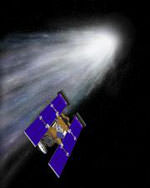
Image credit: NASA/JPL
In less than 2 days, NASA’s Stardust spacecraft will fly past Comet Wild 2 – on January 2 at 0740 UTC (2:40 am EST). The spacecraft has already entered the comet’s halo; the cloud of dust and gas surrounding its nucleus. This is a dangerous part of the journey because the spacecraft could collide with particles from the comet which are moving at 6.1 kilometres per second. In order to minimize any damage, Stardust has several shields made of composite material which dissipate the energy from colliding particles. The spacecraft will collect particles from the comet and then return them to Earth in 2006.
T-minus 48 hours and counting to a historic rendezvous, NASA’s Stardust spacecraft has officially entered a comet’s coma, the cloud of dust and gas surrounding the nucleus. Stardust is scheduled to hurtle past comet Wild 2 on January 2, 2004, at approximately 2:40 a.m. EST.
“Just like in Star Trek we have our shields up,” said Tom Duxbury, Stardust program manager at NASA’s Jet Propulsion Laboratory (JPL), Pasadena, Calif. “The spacecraft has entered Wild 2’s coma, which means at any time we could run into a cometary particle. At 6.1 kilometers per second (approximately 3.8 miles per second), this is no small event.”
To protect Stardust against the blast of expected particles and rocks as it travels approximately 300 kilometers (186 miles) from the Wild 2 nucleus, the spacecraft rotated, so it is flying in the shadow of its “Whipple Shields”. The shields are named for American astronomer Dr. Fred L. Whipple. In the 1950s, he came up with the idea of shielding spacecraft from high-speed collisions with bits and pieces ejected from comets.
The system includes two bumpers at the front of the spacecraft, which protect Stardust’s solar panels, and another shield protecting the main spacecraft body. Each of the shields is built around composite panels designed to disperse particles as they impact. Blankets of Nextel ceramic cloth that dissipates and spreads debris augment them.
Stardust has traveled approximately 3.7 billion kilometers (approximately 2.3 billion miles) since its February 7, 1999 launch. It is closing the gap with Wild 2 at 22,000 kph (approximately 13,640 mph).
On Jan. 2, Stardust will fly through the halo of dust and gas that surrounds the nucleus of comet Wild 2. While large portions of the spacecraft will be hidden behind Whipple shields, others are designed to endure the celestial sandblasting as they collect, analyze and store samples. The Stardust spacecraft will return to Earth in January 2006, and its sample return capsule will make a soft landing at the U.S. Air Force Utah Test and Training Range. The collected microscopic particle samples of comet and interstellar dust will be taken to the planetary material curatorial facility at NASA’s Johnson Space Center, Houston, for analysis.
Stardust’s cometary and interstellar dust samples may help provide answers to fundamental questions about the origins of the solar system. More information about the Stardust mission is available on the Internet, at:
Stardust is part of NASA’s Discovery Program of low-cost, highly focused science missions. It was built by Lockheed Martin Space Systems, Denver, and is managed by JPL for NASA’s Office of Space Science, Washington. JPL is a division of the California Institute of Technology in Pasadena, Calif. The principal investigator is astronomy professor Donald E. Brownlee of the University of Washington in Seattle.
Original Source: NASA News Release
